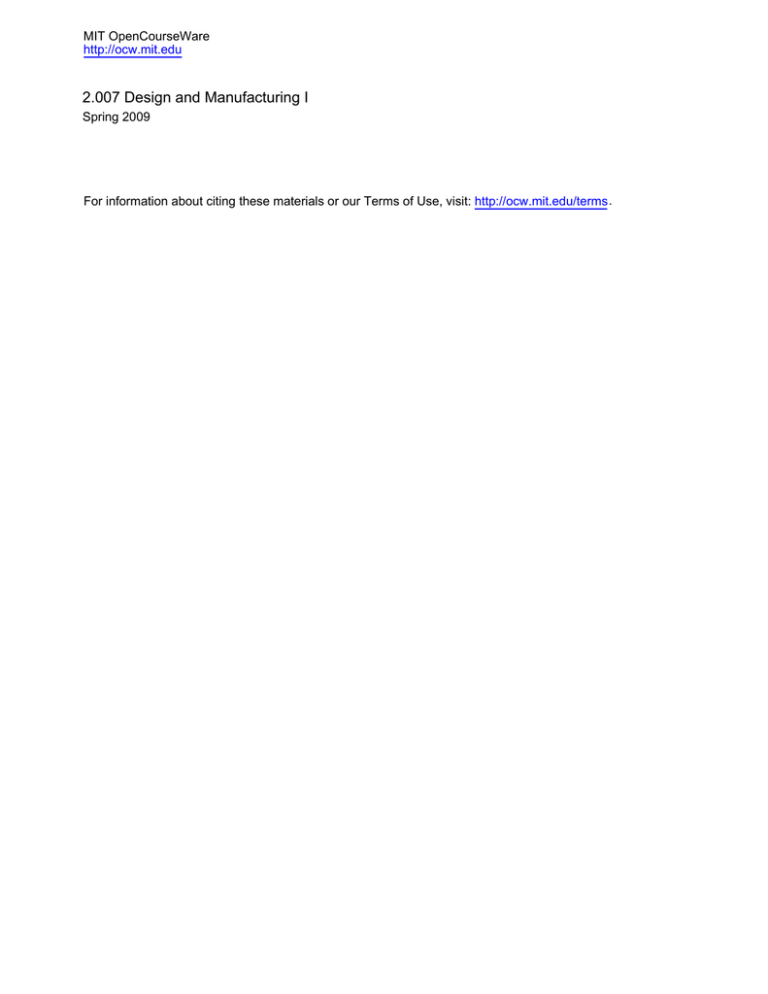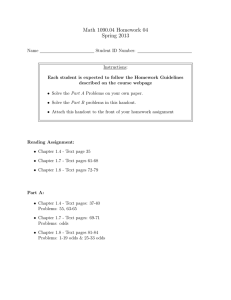Document 13664473
advertisement

MIT OpenCourseWare http://ocw.mit.edu 2.007 Design and Manufacturing I Spring 2009 For information about citing these materials or our Terms of Use, visit: http://ocw.mit.edu/terms. 2.007 UA Lecture #2: Time Management and Organization Scheduling: Consider filling out the schedule below to better manage remaining time. Think about allotting time to: -practice driving before the competition -build robot components -test design, fix problems ****Build in extra time for problem solving when things go wrong! Ideas for Lab Notebooks: • Documentation of thought process (for design, experiment, building) -SolidWorks parts: formal drawings and/or screenshots of parts/assemblies -photographs of completed parts -pencil sketches (dimensioned if necessary) -Internet/Resource generated ideas, pictures (cite source) • Making calculations: -Equations used for calculations -Back of the envelope calculations -state assumptions and estimations -More detailed calculations and graphs (by hand, Microsoft Excel, MatLab, MathCAD, etc.) -Results – interpretation of significance of results • Charts: -Pugh Chart, FRDPARRC -Pro/Con list, any chart that helps organize ideas • Key features well-recorded (i.e. MCM) • Address problems with design, design optimization • Be creative Example: The below simple calculations for a designed lever arm should give you an idea of how to approach documenting and performing calculations on parts for your robot (especially for the MCM and other modules) Concept: • lever arm attached to servo wheel – attached in two places by rivets (see solid model and picture below) Estimated Operation Parameters: arm length = 5-9cm applied force = 1-3N Problem: How much power can be obtained with the above operation parameters? When is power maximized? How does the power output compare with the maximum servo power output? Assumptions about arm: • Force is applied approximately at the tip • Weight of the aluminum and arm, small compared to applied force, considered negligible • Rotation of 45º occurs in approximately 1 second (for simplified calculation) • Assume angular velocity remains constant with load application Relevant Servo Specifications: Hi-Tec HS805BB Stall Torque (at 6.0V) = 24.7 kg·cm Operating Angle = 45º/one side pulse traveling 400μsec Equations for Arm: Γ = F ×r Γ: torque, F: applied force, r: radius (length of arm) P = Γ ×ω ω: angular velocity Calculations: ω = 45º/1sec = 0.785 rad/sec Γmax = 24.7 kg·cm · 9.8 m/s2 = 2.42 N·m (from servo specifications) Pmax = Γmax · ω = 1.9 W Arm Length (cm) Applied Force (N) 5 1 Torque (Nm) 0.05 Angular Velocity (rad/sec) 0.785 Power (W) 0.03925 6 7 8 9 5 6 7 8 9 5 6 7 8 9 1 1 1 1 2 2 2 2 2 3 3 3 3 3 0.06 0.07 0.08 0.09 0.1 0.12 0.14 0.16 0.18 0.15 0.18 0.21 0.24 0.27 0.785 0.785 0.785 0.785 0.785 0.785 0.785 0.785 0.785 0.785 0.785 0.785 0.785 0.785 0.0471 0.05495 0.0628 0.07065 0.0785 0.0942 0.1099 0.1256 0.1413 0.11775 0.1413 0.16485 0.1884 0.21195 0.25 Power (W) 0.2 Force = 1N 0.15 Force = 2N 0.1 Force = 3N 0.05 0 0 2 4 6 8 10 Arm Length (cm) Interpretation of Results: A maximum power is reached with a maximum arm length and maximum applied force with the given parameters. With the given parameters, power appears to fall significantly under the estimated power maximum for the servo. More power can be obtained from the servo by increasing arm length and increasing the applied force.




